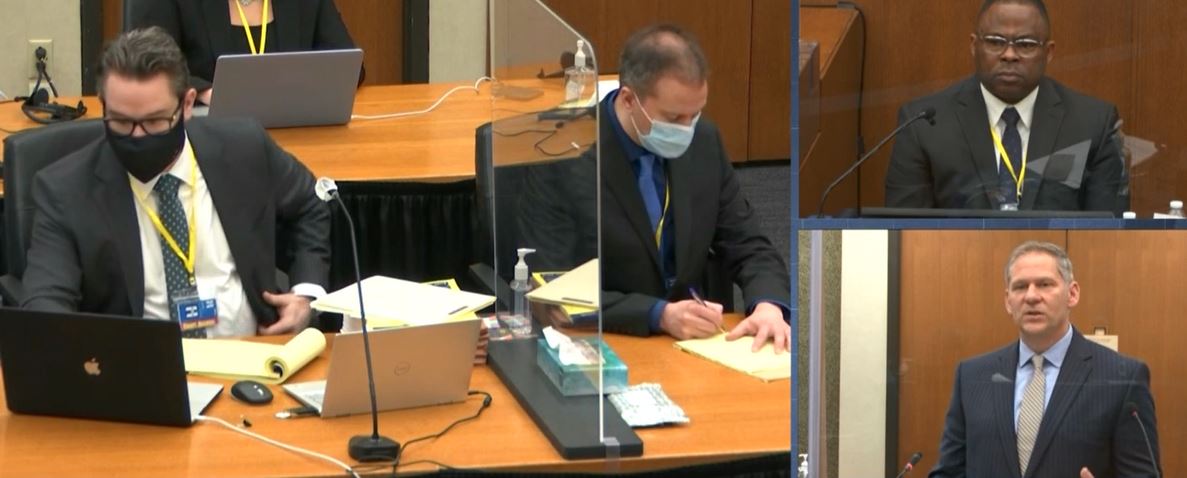Day 8 of the Derek Chauvin murder trial began with a bang for the defense with footage revealing George Floyd said, “I ate too many drugs” while laying on the pavement.
Los Angeles Police Sgt. Jody Stiger
Testimony with paid use of force “expert” Sgt. Jody Stiger resumed Wednesday. During cross-examination, Defense Attorney Eric Nelson played a bombshell clip.
“On camera, officer Kueng’s body-worn camera, starting at 14:21, I’d like you to see if you can tell me what Mr. Floyd says,” Nelson asked Stiger before playing the footage.
Please follow Maryam Henein on Twitter
You can support her work on Patreon
Follow Maryam on Telegram and Gab
“Does it sound like he says, ‘I ate too many drugs?’”
“I can’t make that out,” Stiger responded, despite Nelson playing it twice.
#BREAKING: "I ate too many drugs," #GeorgeFloyd said while laying on the ground.
Defense attorney cross-examines LAPD Use of Force Expert.
Play Now!@Perpetualmaniac 👇💥 pic.twitter.com/hHowOBSaij
— Maryam Henein/ #Shadowbanned (aka BeeLady) Sassy (@MaryamHenein) April 7, 2021
At this point Nelson made the case that due to the agitated bystanders — a theme in his defense — details can go unnoticed.
“In the chaos of a situation, things can be missed, right?”
“Yes,” Stiger agreed.
Now before we finish cross examination highlights, let’s go back to the State’s questioning.
On Tuesday, when asked about Chauvin’s use of force against Floyd, Stiger said, “my opinion was that the force was excessive.”
“Initially, when Mr. Floyd was being placed in the backseat of the vehicle, the officers were justified in trying to have him comply and sit in the backseat of the vehicle,” Stiger said. “However, once he was placed in the prone position on the ground, he slowly ceased his resistance, and the officers — or ex-officers I should say — should have slowed down or stopped their force.”
The prosecution hired Stiger to analyze numerous videos from the scene, court records, and other documents.
“As the time went on, clearly in the video you can clearly see that Mr. Floyd’s health was deteriorating, his breathing was deteriorating, his tone of voice was deteriorating, his movements are starting to cease,” he said.
He continued, “as a police officer you realize something is not right … so you have a responsibility to take some sort of action.”
When discussing pain compliance, Prosecutor Steve Schleicher asked: “You would inflict pain for the purpose of having the subject obey your commands?”
“Yes,” Stiger said.
“What if there’s no opportunity for compliance?” Schleicher asked.
“At that point, it’s just pain,” Stiger said.
Stiger also testified about the dangers of positional asphyxia, and how it contributed to Floyd’s death.
“At the time of the prone restraint period, Mr. Floyd was not resisting. He was in a prone position, he was handcuffed, he was not attempting to evade, he was not attempting to resist,” Stiger said. “The pressure that was being caused by the body weight would cause positional asphyxia which could cause death.”
Even without the additional body weight from three officers, Stiger said he was in danger of positional asphyxia.
Note that Chauvin is only 5’9 and a slender 140 pounds vs Floyd who is 6’3, and 220 pounds. Floyd has also been described in reports as being 6’6 and 270 pounds.
Schleicher closed questioning by playing Kueng’s body-camera video, with Floyd saying “my neck hurts, my back hurts, everything hurts.”
Back To Cross
At the top of Nelson’s cross examination, Stiger acknowledged he’s actually never been an expert witness on use of force before.
As he continued questioning Stiger, Nelson once again mentioned that suspects are known to lie to avoid arrest or jail time.
He gave examples where Floyd on camera can be seen denying being on drugs despite his erratic behavior and the foamy substance on his mouth consistent with illicit drug use.
Nelson also referenced Floyd pleading with cops by saying, “I am not a bad guy.” Floyd kept saying “I can’t breathe” but at the same time “he was actively resisting being put in the back of the squad car,” Nelson said.
Stiger responded that “even when they are resisting, you want to put them in a side recovery position or sit them up” as soon as possible in order to avoid creating a threat to a suspect’s life.
At one point around 8:19 and 49 seconds officers contemplated using an actual device called the “hobble restraint” but seemingly decided it would take too long to remove it given that EMS were on their way.
Upon viewing body-worn camera video, Stiger remarked that Chuavin was attempting to use “pain compliance” … A technique to get a subject to comply, and as they comply “they are rewarded with a reduction of pain.”
Chauvin appeared to accomplish this by “squeezing fingers or bringing knuckles together, which can cause pain or pulling the hand into the cuff, which can cause pain as well.”
Chauvin is charged with second-degree murder, third-degree murder and second-degree manslaughter
Stiger has never been trained by Minneapolis PD and he was not there the day of the incident.
The State then called their next witness, BCA Senior Special Agent James Reyerson.
You can read reports from past trial days at Maryam Henein’s article archive HERE.
Become a Patron!
Or support us at SubscribeStar
Donate cryptocurrency HERE
Subscribe to Activist Post for truth, peace, and freedom news. Follow us on Telegram, SoMee, HIVE, Flote, Minds, MeWe, Twitter, Gab and Ruqqus.
Provide, Protect and Profit from what’s coming! Get a free issue of Counter Markets today.



Be the first to comment on "BOMBSHELL: “I Ate Too Many Drugs,” George Floyd Said While Laying on the Ground"